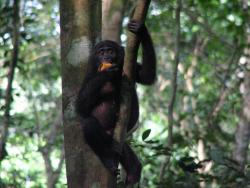Bonobos studied by a Bangor Primatologist unearth a new species of truffle
 Bonobos, an endangered species of great ape.Dr Alexander Georgiev, a primatologist at Bangor University, made an unusual observation while studying apes in the Congo Basin. Dr Georgiev observed that the Bonobos were digging up and eating something that the Congolese field assistants knew to be a type of truffle. Dr Georgiev’s fungal expert collaborators have now identified this truffle to be a new species, previously unknown to science.
Bonobos, an endangered species of great ape.Dr Alexander Georgiev, a primatologist at Bangor University, made an unusual observation while studying apes in the Congo Basin. Dr Georgiev observed that the Bonobos were digging up and eating something that the Congolese field assistants knew to be a type of truffle. Dr Georgiev’s fungal expert collaborators have now identified this truffle to be a new species, previously unknown to science.
Commonly used by Congolese communities to bait traps for small mammals, the new species of truffle, Hysterangium bonobo is also savored by bonobos, an endangered species of great ape. Scientists say the truffle hints at vast reserves of undescribed fungal diversity in the region.
“Kokolopori is an extremely remote field site, in the middle of the Congo Basin, " said Dr Georgiev describing the exciting fieldwork he was involved in. "It was quite a journey getting there, a commercial flight then a seven dayboat trip up the tributaries of the Congo. We had to take a lot of provisions with us, as we spent several months in the field. I travelled there with colleagues from the Bonobo Conservation Initiative and Vie Sauvage, who were also bringing in lots of provisions for the local community.
"Once in the forest, I set up a small research tented camp near a small stream and from there would go to find and follow the bonobos with the trackers from Vie Sauvage. We’d try to keep up with them for the entire day: I’d record what they feed on, try to learn to identify them, and collect data on their movement. It was an exhausting, difficult, but also a very rewarding and exciting experience. (Especially when I saw something that I had never seen them do before – like feeding on truffles!).”
This research is published in the journal Mycologia. Read the full article.
Publication date: 15 October 2020
